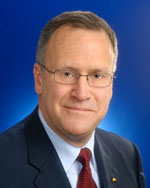The hepatitis C payer negotiations may be making the biggest headlines these days, but diabetes contracts were making headlines first. And if Eli Lilly ($LLY) and its drugs are any indication, those headlines are likely to continue.
During their recent conference call with analysts, Lilly executives gave some hints about their talks with insurers on their new SGLT2 drug Jardiance (empagliflozin) and the even newer GLP-1 drug Trulicity (dulaglutide). And in the process they offered some hints about payers' expectations--and the challenges drugmakers might have in meeting them.
 |
| Eli Lilly CEO John Lechleiter |
CEO John Lechleiter said early this month that the U.S. offers "the last modicum of free pricing" in the global pharma market. And he meant "modicum," because as pharma-watchers know, U.S. payers are flexing their muscles like never before. Enrique Conterno, president of Lilly's diabetes business, has been in the thick of negotiations with payers on the company's two newest diabetes meds, so he knows that as well as anyone.
Trends? The narrow formulary idea, tested by industry leaders Express Scripts ($ESRX) and CVS Health ($CVS), is catching on, with more insurance plans cutting down their drug coverage to exclusive brands. Plus, "the plans that have narrowed their formularies and have made an exclusive decision on a particular drug are not shifting back," Conterno said during the analyst call.
But in negotiations for 2015 formularies there were some shifts, Conterno pointed out. Novo Nordisk ($NVO) "got the higher share of lives going exclusive," he said. Given that Novo is one of Lilly's biggest competitors in diabetes, that's not a good thing. But in a new head-to-head contest with the Danish drugmaker, Lilly sees itself in a good position, he said. Negotiations on Lilly's brand-new Trulicity, a once-weekly GLP-1 treatment for diabetes and direct rival for Novo's blockbuster once-daily Victoza, are going "very well," he said, adding, "We believe that we have a product that adds significant value and that value is appreciated by payers."
Lilly is expecting Trulicity to gain formulary access this year "on a large basis ... across a number of the commercial plans," Conterno said, with Medicare Part D coverage coming next year. More importantly, that access won't depend on big discounts, he said, and nor is Lilly pushing for formulary exclusives. "We are making the value of this product stand in our discussions, so we are not entering into a price war," he said. "What we're trying to basically do is achieve access but not exclude other products while we achieve this access."
With Jardiance, the SGLT2 inhibitor Lilly developed in partnership with Boehringer Ingelheim, the landscape is more competitive, Conterno said. Johnson & Johnson's ($JNJ) Invokana and AstraZeneca's ($AZN) Farxiga beat Lilly to market, and Jardiance has "maybe less differentiation from the other products" than with Trulicity, where dosing is a clear difference from its rivals. "[B]ut we see good progress in our discussions on contracting" with Jardiance as well, Conterno added.
And here's a lesson for drugmakers within diabetes and without. David Ricks, president of Lilly's biomedicines group, pointed out that payers have the most power in areas where there's less differentiation, whether that's within drug classes or among different classes in the same field. In those areas, payers "can drive therapeutic switching," particularly with their newly narrowed formularies, Ricks noted. "So there is a trend to having increasingly narrow formularies bit by bit each year, and where we have less differentiation in our products, I think one would worry more about that," Ricks said. "Where there is differentiation ... we can command value for the products and achieve formulary access at the same time."
Oh, and by the way. While Lilly's negotiators were working with payers to get formulary access and pricing set up for new diabetes products, sales execs were making their plans for pumping up sales on those newly launched drugs. They'll continue spending money and putting talent to work to make those launches successful. But that doesn't mean any increases in budgets. The company intends to hold the line on spending this year, "despite increased full-year spend on recently launched products." How? By "redirecting resources" from older brands.
Special Reports: Top 10 best-selling diabetes drugs of 2013 | The FDA's new drug approvals of 2014